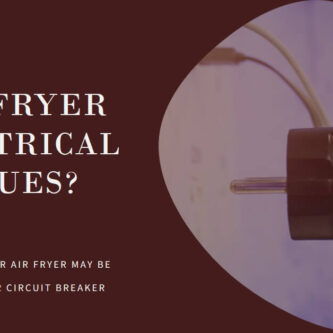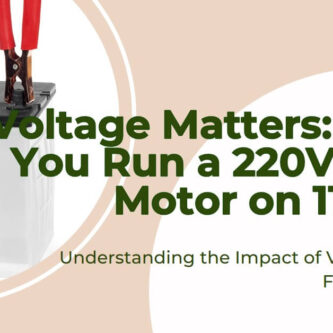Electric heaters are an essential appliance for many households, providing warmth during the cold winter months.
However, there may be situations where you need to use a heater designed for a different voltage than the one available in your home.
One common question is whether you can run a 220V heater on 110V power. In this article, we’ll explore the answer to that question and the potential issues that come with it.
Understanding Electric Heaters
Before we dive into whether a 220V heater can run on 110V power, let’s first understand how electric heaters work.
Electric heaters convert electrical energy into heat energy through a process called resistive heating. The heater element, usually made of metal wire, resists the flow of electric current, which generates heat.
The power rating of an electric heater determines its ability to generate heat. The power rating is usually measured in watts and indicates how much heat the heater can produce.
For example, a 1500-watt heater can generate 1500 watts of heat, while a 500-watt heater can generate 500 watts of heat.
Calculating the power rating of an electric heater is straightforward. You can simply multiply the voltage by the current (in amps) to get the power in watts.
For instance, a 220V heater that draws 6.8 amps of current will have a power rating of 1496 watts (220V x 6.8A = 1496W).
Running a 220V Heater on 110V
The theoretical calculation suggests that a 220V heater would draw twice as much current when connected to 110V power.
However, this is not always the case due to the effect of resistance on the current draw. When the voltage is reduced, the resistance of the heater element increases, which limits the current draw.
As a result, the current draw of a 220V heater connected to 110V power will be lower than its rated current.
For example, suppose we have a 220V heater with a power rating of 1500 watts and a rated current of 6.8 amps.
The theoretical calculation suggests that the heater would draw 13.6 amps when connected to 110V power.
However, due to the effect of resistance, the actual current draw will be around 3.4 amps (1500W/110V = 13.6A x 0.25 = 3.4A).
This lower current draw means that the heater will not generate as much heat as it would at 220V, resulting in reduced performance.
Potential Issues of Running a 220V Heater on 110V
Reduced performance is not the only issue with running a 220V heater on 110V power. The inefficiency of the heating process can also cause issues.
When the voltage is reduced, the current draw is lower, but the heating element’s resistance increases.
This results in less efficient heating, as the heater element has to work long periods of time to generate the same amount of heat.
Moreover, running a 220V heater on 110V power can also result in heating capacity limitations.
If the heater is already at its maximum heating capacity at 220V, it will not be able to generate more heat when connected to 110V power.
Read also my comprehensive article: Beware: Running a 220V Appliance on 110V Can Cause Damage
Safety Considerations
Another issue to consider is the safety aspect of running a 220V heater on 110V power.
If the heater has electronic parts, such as a digital display, the lower voltage can cause damage to those parts. This damage can be costly to repair and may result in the heater being unusable.
Electronic Components
One potential issue with using a 220V heater on a 110V outlet is that electronic components within the heater may not be designed to handle the lower voltage.
For example, if the heater has a digital display or other electronic controls, the lower voltage may cause damage to these components.
In some cases, this damage may be permanent and render the heater unusable. It’s important to carefully read the manufacturer’s specifications and guidelines before attempting to use any electrical device on a voltage that is different from its intended operating voltage.
How to Run a 220V Heater on a 110V Outlet
If you find yourself in a situation where you need to use a 220V heater on a 110V outlet, a voltage transformer can be used.
A voltage transformer converts the voltage from one level to another, allowing the device to operate at the required voltage level.
However, it’s important to note that using a voltage transformer will increase the cost and complexity of using the heater, and it may not be a practical solution for everyone.
Conclusion
In summary, it is not safe to run a 220V heater on a 110V outlet without using a voltage transformer.
Doing so may result in damage to the heater, and potentially pose a safety hazard. It’s important to carefully consider the power requirements of any electrical device before attempting to use it on a different voltage level.
If you are unsure about the proper usage of a particular device, consult the manufacturer’s instructions or a qualified electrician for guidance.
By understanding the potential risks and limitations of using a 220V heater on a 110V outlet, you can make an informed decision about whether or not it is the right choice for your needs.
While it may be tempting to try to save money by using the heater on a lower voltage, the potential risks and safety hazards associated with doing so may outweigh any potential cost savings.
It’s always better to err on the side of caution when it comes to electrical devices and their proper usage.
you work With Electricity! Don’t leave empty-handed!
Looking to stay ahead of the game in the world of electrical engineering? Subscribe to my YouTube channel and gain access to exclusive content you won’t find anywhere else!
The staff I recommend (Amazon Affiliate Links to products I believe are high quality):
- Economy 120 Volt/60Hz AC Power Source – Step-Down Voltage & Frequency Converters 1800W
- UNI-T Digital Multimeter Tester UT139C
- 50-Amp Extension Cord for RV “100ft”
- Voltage Stabilizer 110/220v
- Hair Dryer “best selling“
- TOSHIBA EM131A5C-BS Countertop Microwave Ovens
Disclaimer: This contains affiliate links to Amazon products. I may earn a commission for purchases made through these links.



